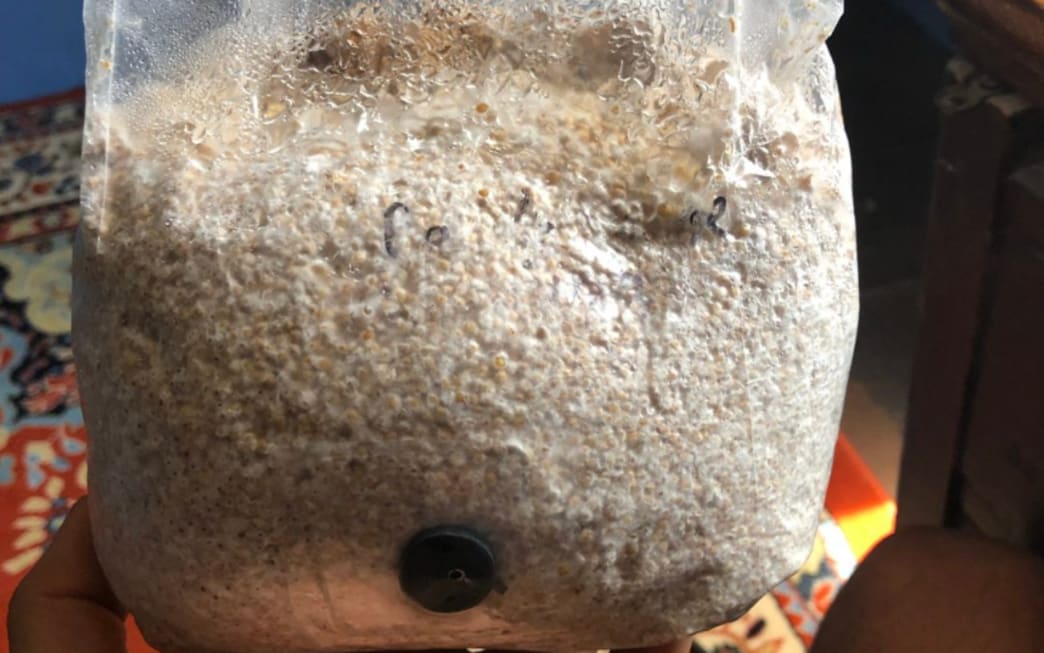Learn about mushroom grain spawn, including how to make your own. You can also buy grain spawn from us and we provide an array of species
The mushroom grain spawn we provide is similar to sawdust spawn with a few caveats.
This mushroom grain spawn is perfect for indoor mushroom cultivation. This is true because the small particle size of the millet allows the mushroom mycelium to grow quickly, leading to a well-colonized substrate.
Are you interested in using grain spawn but are not fully sure as to the best methods for growing mushrooms with it? We recommend using grain spawn if you are growing mushrooms indoors on straw, coffee grounds, or supplemented sawdust. As with all other types of spawn, our grain spawn is produced in a sterile lab all year long so you are guaranteed fresh, pure spawn free of contaminants.
The types of mushroom grain spawn we currently have available include:
Understanding the mushroom grain spawn
Grain is used as a high-nutrient medium for rapid mycelial expansion. It is typically the step after mycelial growth on agar medium. Grain spawn provides a major benefit by supplying a pre-colonized Nitrogen source to the substrate. This can help to increase yields from low nitrogen substrates like straw or paper waste.
If you research on the internet for information on mushroom grain spawn, you will likely see that rye is considered to be the gold standard in growing mushrooms on grain.
However, there are some that believe millet is the best grain for mushroom spawn. The reason is because smaller grains like millet allow for more inoculation points from the same amount of inoculum. Larger grains like rye or wheat do not allow for as many inoculation points as they are bigger grains. One pound of rye spawn may have about 200 particles for the mycelium to colonize while millet will have closer to 500. The mycelium will spread more evenly and abundantly through the substrate when using a smaller grain like millet. Similarly, sawdust can be better than larger grains because of the small particle size.
Grain is too expensive and too high in nutrients for bulk substrate fruiting, but can be a good supplement to a sawdust or wood pellet base. It works well to boost yields by inoculating straw with large amounts of grain spawn. Grain also needs to be treated using pressurized steam and inoculated in lab conditions. It is very easy to get contamination on grain, so this is not a beginner substrate.
Understanding the “generations” of grain spawn
The generations of spawn are very straight forward. The first substrate inoculated from a petri plate is usually grain and called Generation 1. This is then expanded 8-10x into more grain which is Generation 2 grain. From here, farmers usually either go to Generation 3 grain or sawdust. Most growers do not perform transfers beyond four generations for fear that the strain will lose vigor in fruiting — a phenomenon called strain senescence.
The mushroom grain spawn we provide is second generation so you can further expand the mycelium several times.
How to cultivate your own mushroom grain spawn
Here is a quick step-by-step process for doing it if you do not want to buy your own from commercial mushroom spawn suppliers like us.
Mix substrate: For substrate we use one part water, one part grain and 1/5 part vermiculite. This works out to about 1,000 grams of water, 1,000 grams of grain (oat is what we have used lately but, wheat, rye, millet all work) and 200 grams of vermiculite. This is layered in the bag grain, vermiculite, and finally water.
Fold bags: This simple step can be the difference between success and failure. Bags that are not folded properly can be extremely difficult to seal, taking longer to do and sometimes not sealing at all. Bags should not have any creases in them or any substrate in the area that is going to be sealed. You have to be extremely picky if you want to cultivate mushroom spawn properly.
Load pressure cooker. When loading an all-American pressure cooker we typically will load the first bag against the column, which will be the last bag to come out. With a 41 quart sterilizer we do two layers of five-pound bags. Each layer has three bags. The first bag on the top layer is in the space between the handles. With this orientation bags can be pulled out without ripping the sides.
Inoculate. Inoculation should happen in front of a flow hood. Grain spawn is high in nutrients so it can contaminate easily, which is why a flow hood is important.
Incubate. Once inoculated, bags should be kept between 60-75 degrees Fahrenheit during incubation. Spawn typically takes about two to three weeks to colonize.
If you don’t have the equipment or space needed to make your own mushroom grain spawn at home, you can buy from us now.

